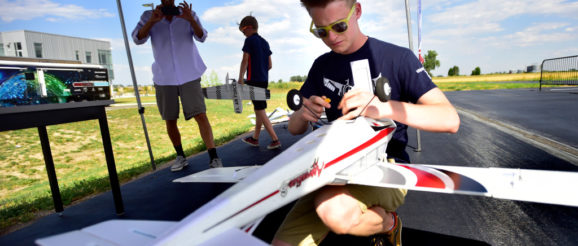St. Vrain Valley School District unveils new mobile Innovation Lab – Longmont Times-Call

The St. Vrain Valley School District’s new Innovation Lab made its official debut Monday outside the Innovation Center in Longmont.
The lab is a 45-foot-long custom motorcoach built by Farber Specialty Vehicles of Ohio for $809,135. Sponsoring businesses — Crestone Peak Resources, IBM, Stapp Interstate Toyota, UCHealth and United Power — covered the full cost.
The mobile lab can demonstrate technologies that include iPads, virtual and augmented reality, robotics, aviation, 3D printing, laser cutting, 360 video production, audio editing and graphic design.
Deputy Superintendent Jackie Kapushion said the first big goal is to use the lab to highlight what’s already happening in schools.
“We want people to understand that public education is changing, and we’ve really worked hard with businesses to prepare students for what comes next,” she said.
The second goal, she said, is to work with businesses to use the mobile lab as a testing ground for new technologies. The district also can pre-pilot virtual reality headsets, for example, in a small setting before buying them for a whole class or school.
On Monday, the lab was set up to show the design thinking process with oceans as the theme. Students at the Innovation Center worked as tour guides.
“I love interacting with members of the community,” said Bella Mendoza, a senior at Silver Creek High School. “We can show how we use the technology in a real way to solve problems. It’s such a valuable learning tool.”
Her favorite feature of the lab, she added, is a mathematical construction toy.
“It’s so cool,” she said.
The tour started with the first step in the design process, understanding and empathize with the issue — in this case, ocean pollution.
To learn about the problem, there were virtual reality headsets that showed scientists working on research in the ocean, augmented reality iPads showing underwater scenes with sharks and a video call allowing participants to ask questions of shark researcher Mikki McComb-Kobza, executive director of the Ocean First Institute.
Next was an opportunity to check out a shark jaws display and then brainstorm ideas for solutions on sticky notes. Last, community members could try their hand at prototyping at a station set up outside.
Using low-tech materials like PVC pipe and foam combined with Sphero robots, participants could try to design something that would clean plastics (Lego pieces) floating in the ocean (a small pool of water.)
Colin Rickman, a district technology coordinator overseeing the prototyping station, emphasized that technology is only a tool to help students access learning.
“The innovation is the learning itself,” he said.
The lab’s next public stop is the Unity in Community event Friday in downtown Longmont.
District officials said the initial focus will be getting the lab out to events with the sponsors, then adding more community events and eventually taking the lab around the state.
For schools, future plans include having students in high school focus programs, such as the biomedical programs at Longmont High and Frederick High, develop a curriculum to highlight what they’re learning. They would use the Innovation Lab to present the curriculum to elementary and middle school students.
The lab also could be used by teachers to try different technology as they develop lessons, or for small groups of students to work on projects.
Examples of possible programs include a design thinking challenge in which students work with industry experts to design the hospital room of the future, a collaboration space where high school students can teach a robotics lesson to elementary students, and a mobile classroom to show energy industry innovations to multiple schools.
“We can pique people’s interest in future technology and connect the community to with the education system,” said Calvin Tran, a sophomore at Skyline High School.
